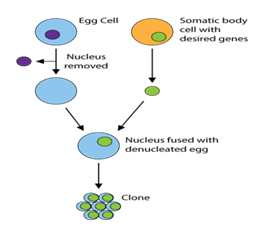

Context
A wild Arctic wolf was successfully cloned for the first time in the world by a Beijing-based gene firm.
About
About the first cloned wolf
- Cloned Arctic wolf is the first case of its kind in the world. It is named ‘Maya’.
- The donor cell of the wolf came from the skin sample of a wild female Arctic wolf and its oocyte was taken from a female dog.
- Maya’s surrogate mother was a beagle, a dog breed.
- The dog was selected as the surrogate as it shares genetic ancestry with ancient wolves and hence, ensures success in cloning.
|
In 1996, Scottish scientists cloned the first animal, a sheep they named Dolly. She was cloned using an udder cell taken from an adult sheep. |

What is Cloning?
- The term cloning describes a number of different processes that can be used to produce genetically identical copies of a biological entity.
- The copied material, which has the same genetic makeup as the original, is referred to as a
|
Artificial Cloning There are three different types of artificial cloning: gene cloning, reproductive cloning and therapeutic cloning. 1. Gene cloning produces copies of genes or segments of DNA. 2. Reproductive cloning produces copies of whole animals. 3. Therapeutic cloning produces embryonic stem cells for experiments aimed at creating tissues to replace injured or diseased tissues. |
- Natural clones, also known as identical twins, occur in humans and other mammals.
- These twins are produced when a fertilized egg splits, creating two or more embryos that carry almost identical DNA.
- Identical twins have nearly the same genetic makeup as each other, but they are genetically different from either parent.



